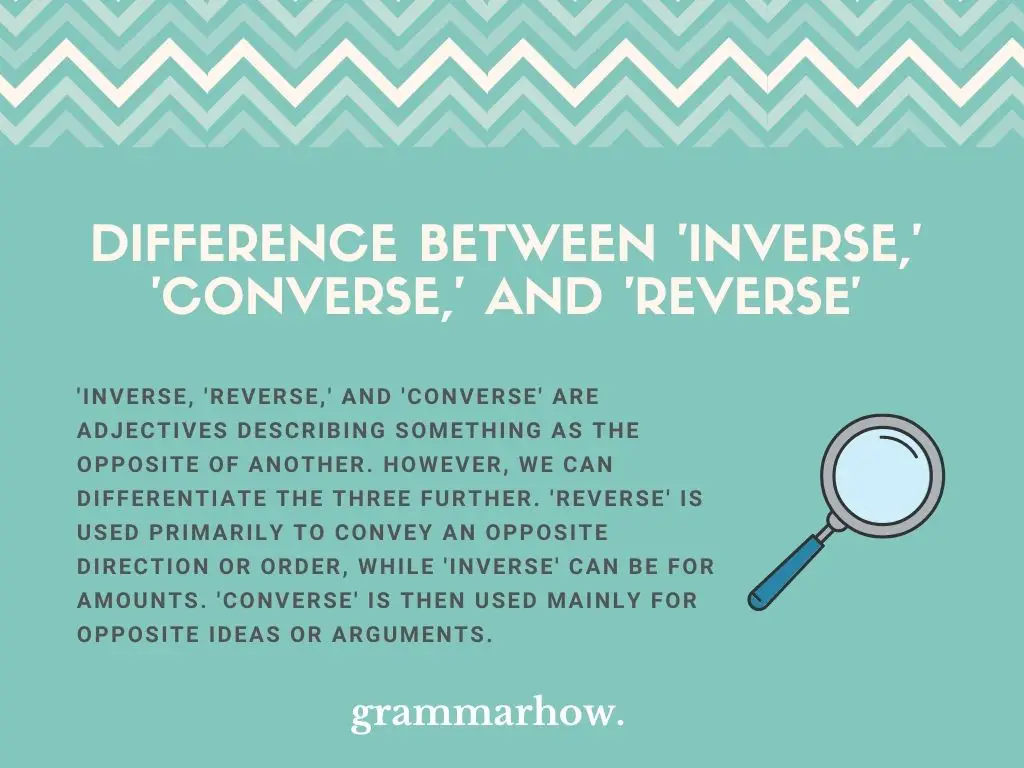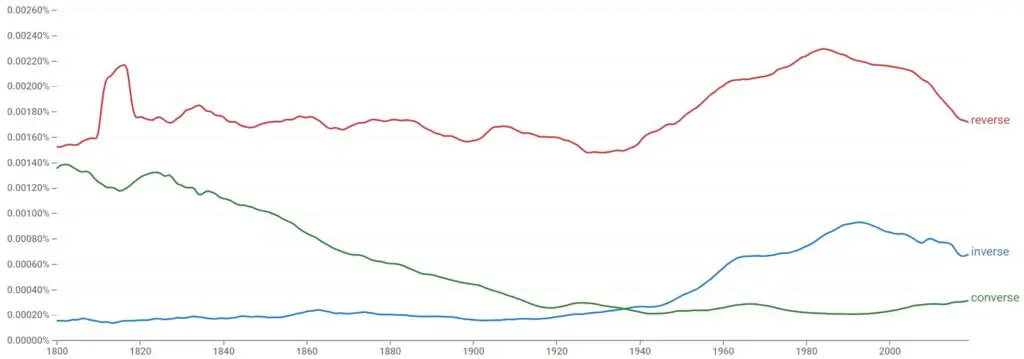With the ever-so-growing English language, there are many words with similar rings. And, I’m not just talking about words that rhyme, but even those with confusing and overlapping meanings too! It’s even harder to distinguish if they sound alike and mean alike! Take inverse, reverse, and converse, for example!
What Is The Difference Between ‘Inverse,’ ‘Converse,’ And ‘Reverse?’
‘Inverse, ‘reverse,’ and ‘converse’ are adjectives describing something as the opposite of another. However, we can differentiate the three further. ‘Reverse’ is used primarily to convey an opposite direction or order, while ‘inverse’ can be for amounts. ‘Converse’ is then used mainly for opposite ideas or arguments.

While we can interchange them at times, each word has a context they are most appropriate to use. So, it’s best to follow that. These three adjectives are also acceptable in formal and casual English. However, not many people use them often in daily conservations.
What Does ‘Inverse’ Mean?
‘Inverse’ is an adjective we use to describe something that is the exact opposite of another thing. We use it most of the time in math to express the relationship between two variables or show differences in ranking, order, or position.
According to the Cambridge Dictionary, ‘inverse’ means ‘opposite in relation to something else.’ It can also mean ‘changing in an opposite direction in relation to something else, esp. an amount.’
Below are examples of how we use ‘inverse’ in a sentence.
- She keeps changing sides. What she just said was the inverse of her initial proposal to us. It’s hard to trust her if other people can easily sway her with their arguments.
- I think we have an inverse relationship with each other. When I keep looking for you, you don’t want me. And when you keep looking for me, I don’t show up.
- Division and multiplication are inverses of each other. Division keeps the number decreasing every time you divide it with another number, while multiplication keeps the number increasing.
- The funds the two teams earned during the fundraiser are inverses to each other. Team A had a total sold-out during all three days, making them earn over ten grand. Team B, however, didn’t even sell half of their items, earning only a little over four grand.
- Your words are the inverse of what your sister said to me a while ago. If both of you were together at the same event, one of you is lying. Both of your stories don’t match at all.
What Does ‘Converse’ Mean?
We use ‘converse’ if we need an adjective to show opposites of something. Most of the time, we use this word to express opposing ideas, theories, arguments, or anything abstract. If we use it as a verb, ‘converse’ can also mean talking or having a conversation with someone.
According to the Cambridge Dictionary, ‘converse’ means ‘the opposite.’ It can also mean ‘to have a conversation with someone’ as a verb.
Below are examples of how we use ‘converse’ in a sentence.
- This theory that our teacher is discussing right now is the converse of what she taught us a while ago. I know it can get confusing, but you can think of the two theories as opposites instead.
- I know that we both have converse opinions. However, even if we don’t hold the same insights all the time, let’s try to keep things professional, especially for the other guests present here.
- Though coming to an agreement is essential, let’s also try to bring converse ideas to the table. It may allow us to see aspects of the project that we didn’t see before.
- I know you say that you’re okay, but I can see from your eyes alone that the converse of what you’re saying is true. You’re not okay, and even that’s okay.
- Maria doesn’t want to converse with us. I guess she is still upset over the mistake that we made. We should apologize to her again.
What Does ‘Reverse’ Mean?
We use ‘reverse’ as a verb, a noun, or an adjective. As either of the three, it has something to do with being the opposite of a particular thing. It can be opposite in direction, going the opposite way, or being opposite of what was expected.
According to the Cambridge Dictionary, ‘reverse’ can mean:
- ‘to change the direction, order, position, result, etc. of something to its opposite,’ or
- ‘the opposite of what has been suggested,’ or
- ‘opposite to what has just happened, or to what is usual or expected, or
- ‘the method of controlling a vehicle that makes it go backward.’
Below are examples of how we use ‘reverse’ in a sentence.
- You’re doing the reverse of what I said. I clearly said to go left, not right. Now, we’re getting lost and getting late for the meeting. I’m just hoping we can find our way soon.
- When the judges announced the results, I was so shocked. It was the reverse of what I had in mind. I thought that Heidi would win, but June won instead!
- Since you know how to move forward, let’s try moving backward now. Put the car in reverse. Then, turn the wheel in the opposite direction as a while ago.
- The second chorus has the same dance steps as the first chorus. The only difference is that you need to dance it in reverse order. So, the step backward comes first.
- To change things up, our teacher reversed the order for recitation. Student number twenty comes first, and student number one comes last. It was an advantage for me because I was student number five.
Are ‘Inverse,’ ‘Converse,’ And ‘Reverse’ Interchangeable?
‘Inverse,’ ‘Converse,’ and ‘Reverse’ are interchangeable because they are synonymous adjectives that all describe being the opposite of something. However, there are limitations to this because it’s not all the time that the three words are appropriate for the given context. So, it’s best to use the most appropriate word.
‘Inverse’ is most appropriate for variables and amounts. ‘Converse’ is utilized for abstract ideas and theories. And, ‘reverse’ is best used for rankings, directions, or order.
Here’s an example of a context where we can interchange them.
- What was executed was the total converse of what we initially planned.
- What was executed was the total inverse of what we initially planned.
- What was executed was the total reverse of what we initially planned.
Here’s an example of a context where we cannot interchange them.
- Original Sentence: Put the car on reverse. Let’s get out of this slot and park on a new one.
- Awkwardly Interchanged: Put the car on converse. Let’s get out of this slot and park on a new one.
- Awkwardly Interchanged: Put the car on inverse. Let’s get out of this slot and park on a new one.
Is ‘Inverse,’ ‘Converse,’ Or ‘Reverse’ Used The Most?
According to the Google Ngram Viewer, ‘reverse’ is used the most, followed by ‘inverse’ and ‘converse.’ It is most probably because ‘reverse’ is the most flexible to use in any given situation, compared to the other adjectives. We use ‘reverse’ more freely and more often in casual interactions.

Another factor is probably because ‘reverse’ can refer to the part in the gearstick in a car that lets it drive backward. Because of this, ‘reverse’ is used more often than the other two adjectives.

Martin holds a Master’s degree in Finance and International Business. He has six years of experience in professional communication with clients, executives, and colleagues. Furthermore, he has teaching experience from Aarhus University. Martin has been featured as an expert in communication and teaching on Forbes and Shopify. Read more about Martin here.
